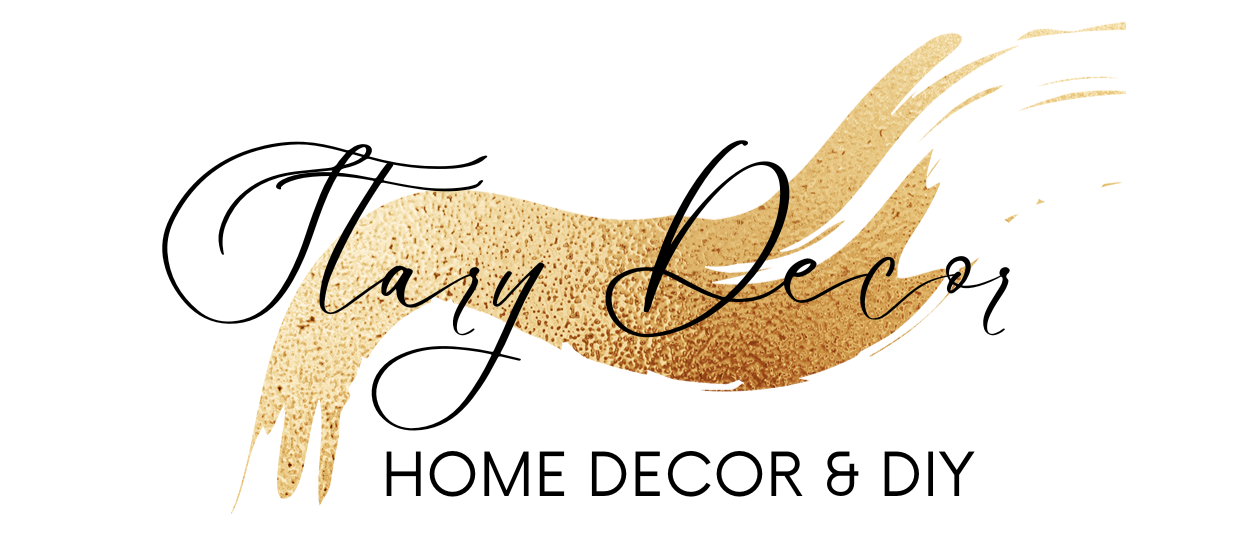Epoxy floor bathroom – Transform your bathroom with epoxy flooring, the perfect choice for a durable, waterproof, and stylish upgrade. Explore the benefits, types, installation process, design considerations, maintenance tips, and more in this comprehensive guide.
From sleek and modern to classic and elegant, epoxy flooring offers endless design possibilities to complement any bathroom decor.
Benefits of Epoxy Flooring for Bathrooms
Epoxy flooring offers numerous advantages for bathrooms, making it an excellent choice for both residential and commercial applications. Its exceptional durability, water resistance, and ease of maintenance make it a practical and stylish solution for these moisture-prone areas.
Enhanced Functionality
- Durability:Epoxy flooring can withstand heavy foot traffic and is resistant to scratches, stains, and chemicals, ensuring longevity in high-use bathrooms.
- Water Resistance:Its non-porous surface prevents water absorption, protecting against mold and mildew growth, common concerns in humid bathroom environments.
- Slip Resistance:Epoxy flooring can be customized with anti-slip additives, providing a safe and secure surface, especially in areas prone to moisture.
Improved Aesthetics
- Seamless Finish:Epoxy flooring creates a smooth, seamless surface, eliminating grout lines and reducing the appearance of dirt and grime.
- Customizable Designs:Epoxy flooring allows for a wide range of design options, including colors, patterns, and even the incorporation of decorative elements, enhancing the overall aesthetics of the bathroom.
- Easy to Clean:Its non-porous surface makes cleaning effortless, requiring only regular sweeping or mopping to maintain its pristine appearance.
Cost-Effectiveness
- Long-Term Savings:Epoxy flooring’s durability and low maintenance requirements result in significant cost savings over time compared to traditional flooring options.
- Reduced Labor Costs:Its seamless application eliminates the need for grouting, saving time and labor costs during installation.
- Improved Property Value:A well-maintained epoxy floor can enhance the value of a property, making it an attractive investment.
Types of Epoxy Flooring for Bathrooms
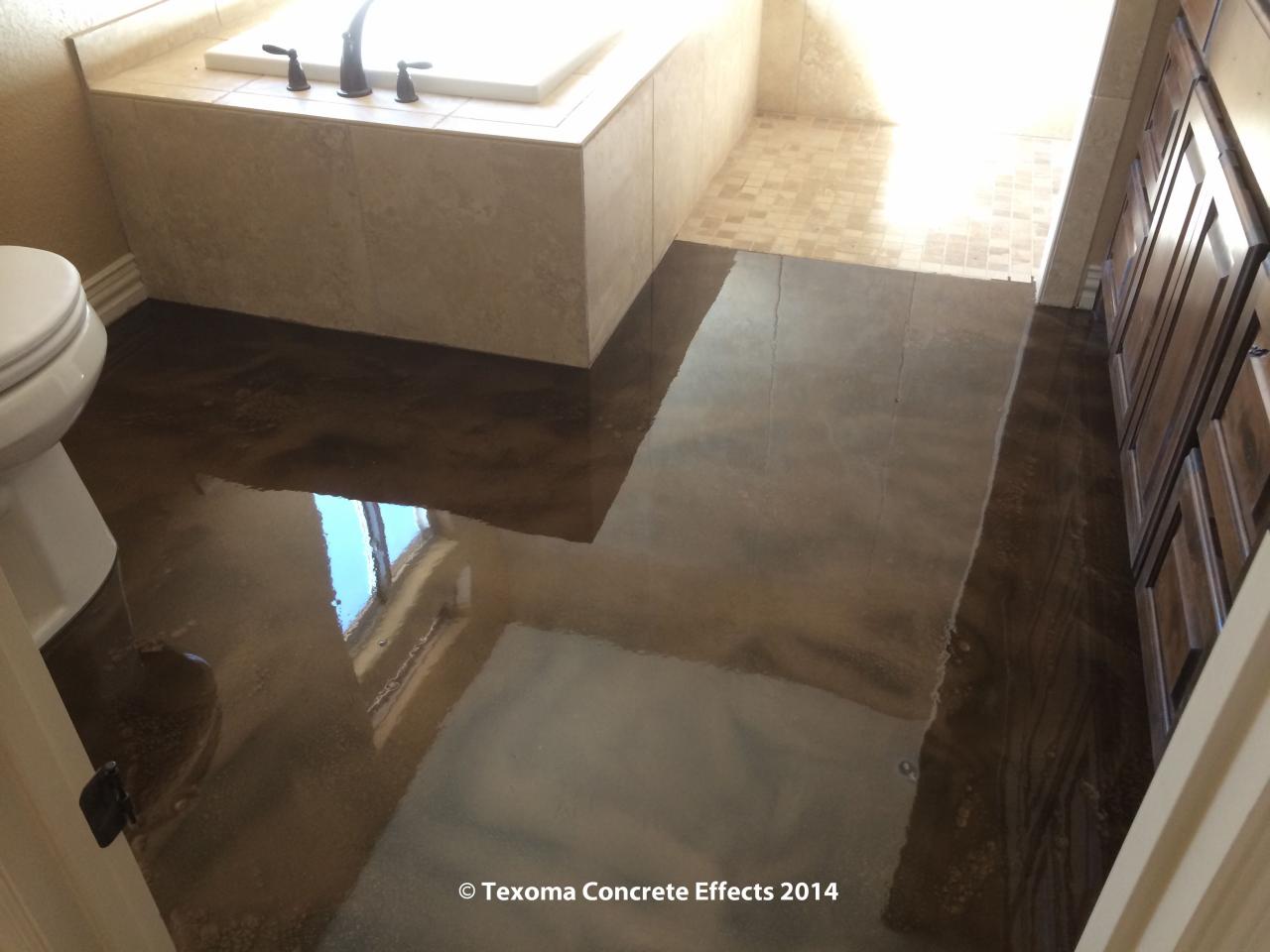
Epoxy flooring offers a versatile range of options for bathrooms, each with unique characteristics suited to different designs and usage patterns. Let’s explore the types available:
Self-Leveling Epoxy
Self-leveling epoxy creates a smooth, seamless surface that flows into any imperfections, resulting in a polished and even finish. It is ideal for bathrooms with high foot traffic or areas prone to spills and moisture.
Quartz-Filled Epoxy
Quartz-filled epoxy incorporates quartz particles, providing increased durability and resistance to wear and tear. This makes it suitable for bathrooms with heavy use, such as commercial or industrial settings.
Metallic Epoxy
Metallic epoxy contains metallic pigments, creating a shimmering, decorative effect. It adds a touch of elegance and can complement bathrooms with modern or contemporary designs.
Installation Process for Epoxy Flooring in Bathrooms
Installing epoxy flooring in bathrooms is a relatively straightforward process that can be completed in a few hours. However, it is important to follow the steps carefully to ensure a successful installation.
Surface Preparation
The first step is to prepare the surface of the bathroom floor. This involves cleaning the floor thoroughly to remove any dirt, dust, or debris. Once the floor is clean, it is important to etch the surface to create a rough texture that will help the epoxy adhere.
This can be done using a chemical etching solution or a mechanical sander.
Primer Application
Once the surface is prepared, a primer should be applied to the floor. The primer will help to seal the surface and create a bond between the epoxy and the floor. The primer should be applied evenly using a roller or brush, and it should be allowed to dry completely before applying the epoxy.
Epoxy Pouring
The final step is to pour the epoxy onto the floor. The epoxy should be mixed according to the manufacturer’s instructions, and it should be poured onto the floor in a thin, even layer. The epoxy should be spread out using a trowel or squeegee, and it should be allowed to self-level.
Once the epoxy has self-leveled, it should be allowed to cure for 24 hours before walking on it.
Tips and Tricks
- Make sure the bathroom is well-ventilated when installing epoxy flooring.
- Wear gloves and a respirator when working with epoxy.
- Apply the epoxy in a thin, even layer.
- Allow the epoxy to cure for 24 hours before walking on it.
- If you are installing epoxy flooring in a shower, make sure to apply a non-slip additive to the epoxy.
Design Considerations for Epoxy Flooring in Bathrooms
When it comes to designing your bathroom with epoxy flooring, the possibilities are endless. With a wide range of color options, patterns, and textures available, you can create a custom look that complements your personal style and bathroom decor.
For a classic and timeless look, opt for a solid-colored epoxy floor in a neutral hue such as white, gray, or beige. If you prefer a more vibrant and eye-catching design, consider using multiple colors or creating a custom pattern.
You can also add interest to your floor by incorporating textures, such as a faux stone finish or a metallic shimmer.
Creative Epoxy Flooring Designs
To inspire your creativity, here are a few examples of unique and stylish epoxy flooring designs for bathrooms:
- A white epoxy floor with a black geometric pattern adds a modern and sophisticated touch to a contemporary bathroom.
- A gray epoxy floor with a faux stone finish creates a luxurious and spa-like atmosphere.
- A metallic epoxy floor with a shimmering finish adds a touch of glamour to a master bathroom.
- A custom-designed epoxy floor with a unique pattern or artwork can create a truly one-of-a-kind bathroom.
When choosing an epoxy flooring design for your bathroom, it’s important to consider the overall decor of the space. If you have a traditional bathroom, a classic solid-colored epoxy floor may be the best choice. For a more modern bathroom, you may want to consider a patterned or textured epoxy floor.
Maintenance and Care of Epoxy Flooring in Bathrooms
Maintaining epoxy flooring in bathrooms is crucial to ensure its longevity and aesthetic appeal. Regular cleaning and proper care techniques will preserve its functionality and appearance.
Cleaning Products and Methods
* Use mild, non-abrasive cleaning solutions designed for epoxy flooring.
- Avoid harsh chemicals, acidic cleaners, or abrasive scrubbers that can damage the surface.
- Use microfiber mops or soft cloths for cleaning to prevent scratching.
- For stubborn stains, use a soft-bristled brush and a mild cleaning solution.
Regular Cleaning
* Sweep or vacuum regularly to remove loose dirt and debris.
- Mop the floor weekly with a damp mop and a mild cleaning solution.
- Rinse the floor thoroughly with clean water to remove any cleaning residue.
- Dry the floor completely with a clean microfiber cloth to prevent water spots.
Importance of Regular Maintenance
* Regular cleaning prevents dirt and grime from accumulating, which can dull the finish and make the floor slippery.
- Proper maintenance protects the epoxy coating from wear and tear, extending its lifespan.
- A clean and well-maintained epoxy floor enhances the overall appearance and hygiene of the bathroom.
Troubleshooting Common Issues with Epoxy Flooring in Bathrooms
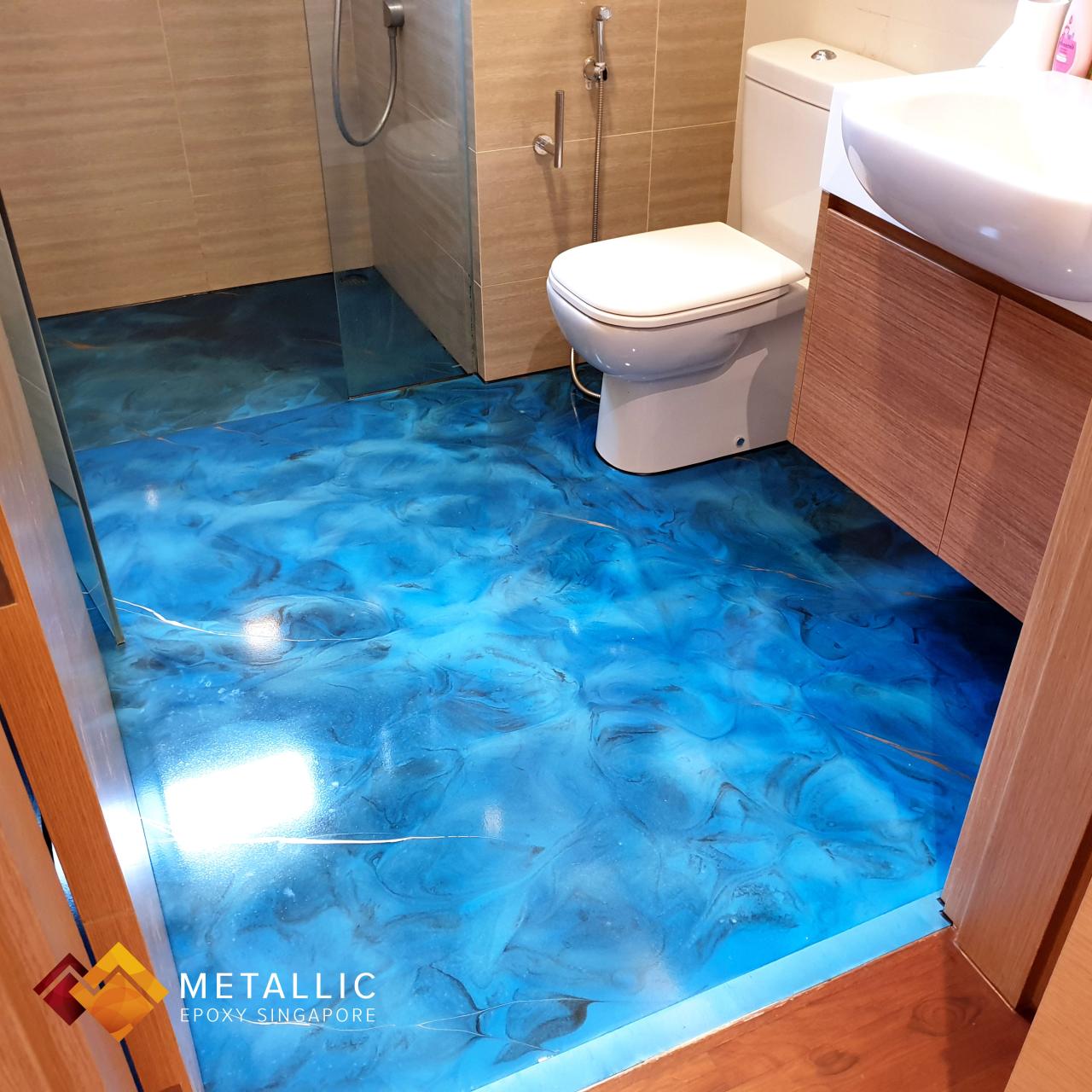
Epoxy flooring is generally durable and long-lasting, but it’s not immune to occasional issues. Here are some common problems that may arise and how to address them:
Peeling
- Causes:Inadequate surface preparation, moisture trapped beneath the epoxy, or improper mixing and application.
- DIY Repair:If the peeling is minor, you can try to re-bond the epoxy using an epoxy adhesive. Ensure the surface is clean and dry before applying.
- Professional Assistance:For extensive peeling, it’s best to contact a professional installer to remove and reapply the epoxy flooring.
Cracking
- Causes:Excessive weight, temperature fluctuations, or improper curing.
- DIY Repair:Small cracks can be filled with epoxy repair compound. For larger cracks, you may need to grind down the area and reapply epoxy.
- Professional Assistance:If the cracks are severe or widespread, it’s recommended to hire a professional to assess the damage and determine the best course of action.
Discoloration
- Causes:Exposure to UV rays, chemical spills, or improper cleaning methods.
- DIY Repair:Try cleaning the discolored area with a mild detergent and water. If that doesn’t work, you can apply a UV-resistant coating to protect the epoxy from further damage.
- Professional Assistance:If the discoloration is significant or persistent, you may need to contact a professional to refinish or replace the epoxy flooring.
Comparison of Epoxy Flooring to Other Bathroom Flooring Options
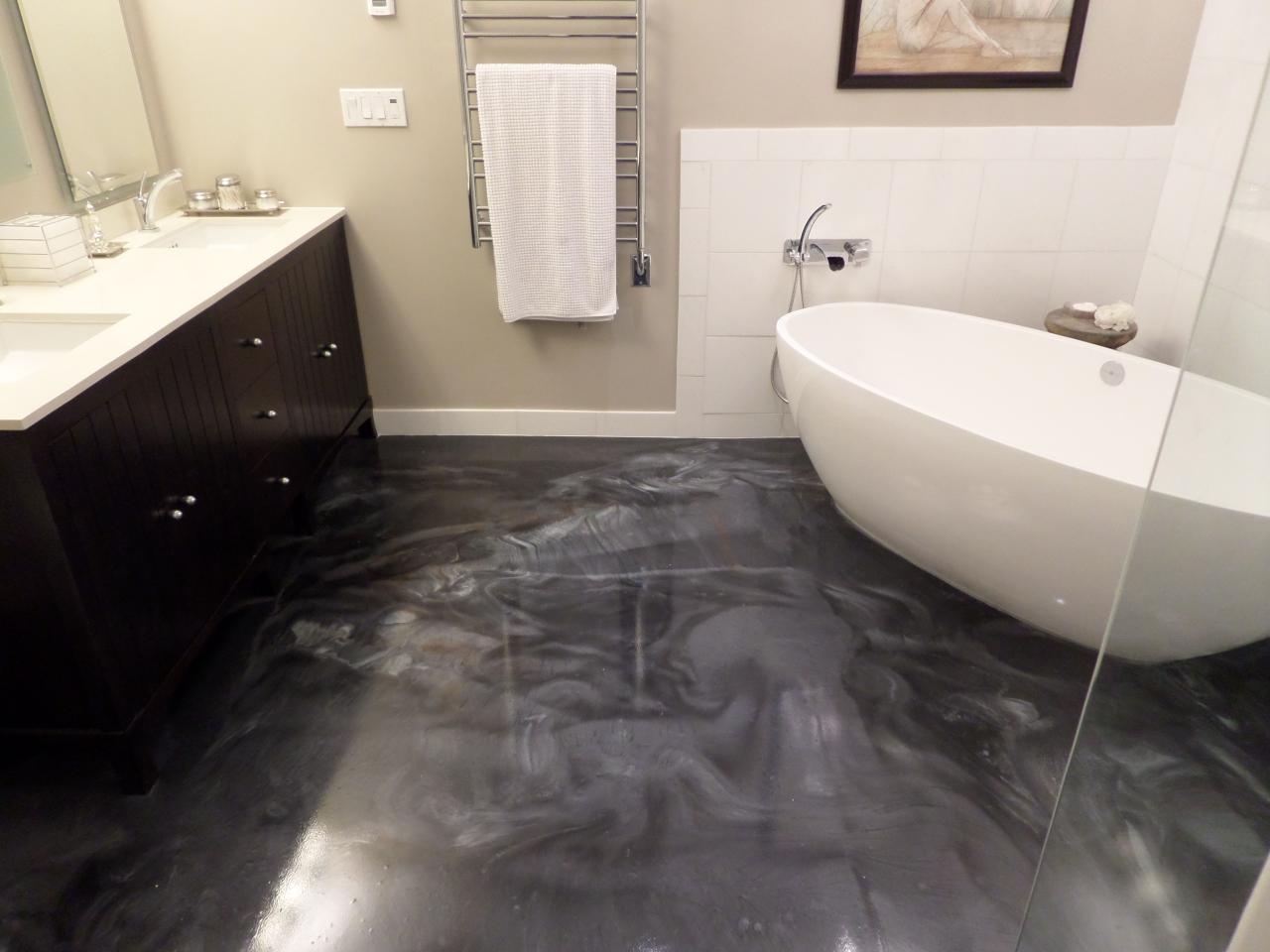
When selecting bathroom flooring, homeowners have various options to choose from. Each type of flooring possesses unique properties, advantages, and disadvantages that cater to specific bathroom needs and preferences. To make an informed decision, it is essential to compare epoxy flooring with other common bathroom flooring options such as tile, vinyl, and laminate.
The following table provides a comparative analysis of these flooring options based on key factors relevant to bathroom applications:
| Epoxy Flooring | Tile Flooring | Vinyl Flooring | Laminate Flooring | |
|---|---|---|---|---|
| Durability | Highly durable, resistant to wear, scratches, and chemicals | Durable, but prone to cracking or chipping if heavy objects fall | Durable, but can be scratched or dented by sharp objects | Less durable, prone to scratches, dents, and moisture damage |
| Water Resistance | 100% waterproof, prevents moisture penetration | Water-resistant, but not waterproof; grout lines can absorb water | Water-resistant, but not waterproof; can be damaged by prolonged water exposure | Not water-resistant; can be damaged by moisture and humidity |
| Maintenance | Low maintenance, easy to clean with mild detergent | Requires regular cleaning and sealing to prevent staining and grout deterioration | Low maintenance, easy to clean with a damp mop | Moderate maintenance, requires occasional cleaning and touch-ups |
| Appearance | Glossy or matte finish, wide range of colors and designs available | Wide range of styles, colors, and patterns available | Available in various textures, colors, and patterns | Resembles hardwood, but limited design options compared to tile |
| Cost | Higher initial cost, but can be cost-effective in the long run due to durability and low maintenance | Moderate cost, varies depending on the type of tile and installation method | Affordable, but may require replacement sooner than other options | Affordable, but less durable than other options |
Factors to Consider When Choosing the Best Flooring Option for a Bathroom
When selecting the best flooring option for a bathroom, several factors should be considered:
- Bathroom Usage:The frequency and intensity of bathroom use will impact the durability and maintenance requirements of the flooring.
- Moisture Exposure:Bathrooms are prone to moisture and humidity, so water resistance is crucial. Epoxy flooring and tile are excellent choices for wet areas.
- Style and Aesthetics:The flooring should complement the bathroom’s overall design and décor.
- Budget:The cost of the flooring, including installation and maintenance, should be considered.
- Maintenance:The ease of cleaning and maintaining the flooring is important for busy households.
Case Studies of Successful Epoxy Flooring Installations in Bathrooms: Epoxy Floor Bathroom
Showcase real-world examples of successful epoxy flooring installations in bathrooms. Include before-and-after photos to demonstrate the transformation. Share testimonials from satisfied customers to highlight the benefits and impact of epoxy flooring in bathrooms.
Before-and-After Transformations
- Before: A bathroom with dull, outdated tile flooring. After: The same bathroom with a sleek, modern epoxy floor that brightens the space and makes it look more inviting.
- Before: A bathroom with a cracked and peeling shower pan. After: The same bathroom with a seamless epoxy shower pan that is both durable and stylish.
- Before: A bathroom with a dark and dingy floor. After: The same bathroom with a light and airy epoxy floor that makes the space feel larger and more welcoming.
Testimonials, Epoxy floor bathroom
- “I love my new epoxy floor! It’s so easy to clean and maintain, and it looks amazing.” – Sarah, homeowner
- “I’m so glad I decided to install epoxy flooring in my bathroom. It’s the best decision I’ve made for my home.” – John, homeowner
- “My epoxy floor is the envy of all my friends. It’s so beautiful and durable, and it’s the perfect addition to my bathroom.” – Mary, homeowner
Inspiration Gallery of Epoxy Flooring Designs for Bathrooms

Epoxy flooring offers endless design possibilities for bathrooms, transforming them into stylish and functional spaces. This gallery showcases a range of visually stunning designs to inspire homeowners and designers.
From classic solid colors to intricate patterns and metallic accents, epoxy flooring can cater to various tastes and styles. Explore the diverse options below to find the perfect design for your dream bathroom.
Solid Colors
Solid-colored epoxy flooring provides a clean and sophisticated base for any bathroom. Choose from a wide spectrum of hues, including neutrals like white, gray, and beige, to bolder shades like navy, emerald green, and burgundy.
- Benefits:Solid colors create a cohesive and elegant look, complementing both modern and traditional bathroom designs.
- Types:Self-leveling epoxy is ideal for solid-colored flooring, ensuring a smooth and seamless finish.
Metallic Accents
Incorporate a touch of glamour into your bathroom with epoxy flooring featuring metallic accents. Shimmering gold, silver, or copper pigments can be added to the epoxy mixture, creating a luxurious and eye-catching effect.
- Benefits:Metallic accents add depth and dimension to the floor, making it a focal point of the bathroom.
- Types:Metallic epoxy flooring can be customized to achieve various finishes, from subtle shimmers to bold, statement-making designs.
Patterns
Geometric patterns, such as checkerboards, stripes, and hexagons, can add a touch of personality and visual interest to your bathroom floor. Epoxy flooring allows for precise and intricate patterns, creating a unique and stylish space.
- Benefits:Patterns can delineate different areas of the bathroom, such as the shower zone or vanity area, while adding aesthetic appeal.
- Types:Stencils, templates, and hand-painting techniques can be used to create various patterns with epoxy flooring.
3D Effects
For a truly immersive experience, consider epoxy flooring with 3D effects. Using specialized techniques, images or graphics can be embedded into the epoxy, creating a realistic and captivating illusion of depth and texture.
- Benefits:3D epoxy flooring transforms the bathroom into a work of art, creating a unique and unforgettable space.
- Types:3D epoxy flooring requires skilled installers who can handle specialized techniques and materials.
Frequently Asked Questions about Epoxy Flooring in Bathrooms
Epoxy flooring is an increasingly popular choice for bathrooms due to its durability, ease of maintenance, and stylish appearance. Here are some frequently asked questions about epoxy flooring in bathrooms, along with clear and concise answers:
Durability
- Is epoxy flooring durable enough for bathrooms?Epoxy flooring is highly durable and resistant to wear, making it suitable for high-traffic areas like bathrooms.
- Can epoxy flooring withstand moisture and humidity?Yes, epoxy flooring is waterproof and resistant to moisture, making it ideal for humid environments like bathrooms.
Maintenance
- How easy is epoxy flooring to clean?Epoxy flooring is easy to clean and maintain. Regular sweeping or mopping with a mild detergent is sufficient.
- Can epoxy flooring be repaired if damaged?Minor scratches or chips in epoxy flooring can be repaired using a patching kit or professional epoxy repair services.
Design Options
- What design options are available for epoxy flooring?Epoxy flooring offers a wide range of design options, including solid colors, metallic accents, and custom designs. You can also add decorative elements like flakes or chips for a unique look.
- Can epoxy flooring be used on bathroom walls?Yes, epoxy flooring can be applied to bathroom walls to create a seamless and waterproof surface.
Additional Questions
- Is epoxy flooring safe for bathrooms?Epoxy flooring is non-toxic and safe for use in bathrooms, even in areas where children or pets may be present.
- How long does epoxy flooring last?Properly installed epoxy flooring can last for 10-15 years or more.
- Is epoxy flooring expensive?The cost of epoxy flooring varies depending on the size of the bathroom, the complexity of the design, and the installer’s rates.
Closing Notes
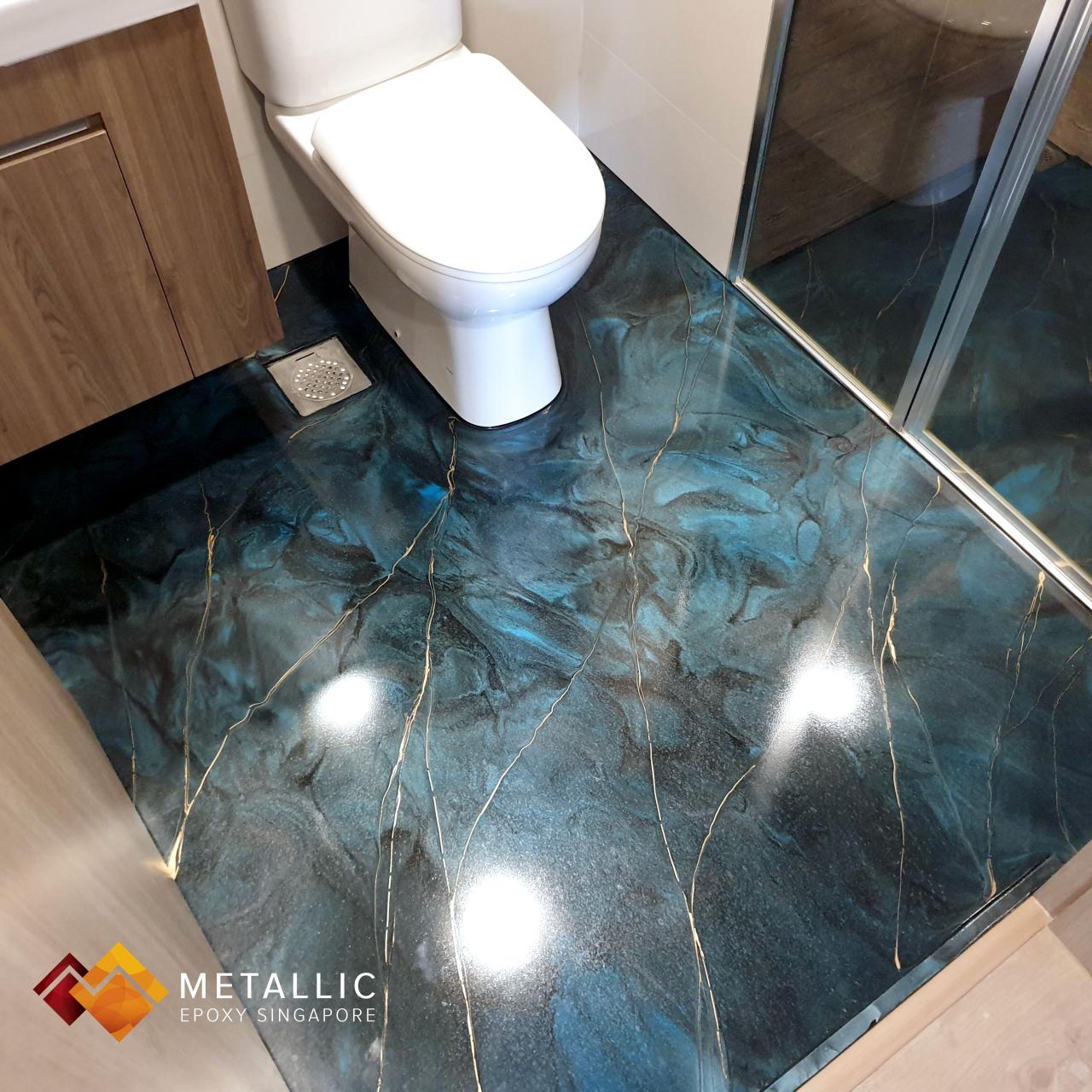
Whether you’re seeking a practical and functional flooring solution or a statement piece that elevates your bathroom’s aesthetics, epoxy flooring is the ideal choice. Its durability, ease of maintenance, and stunning designs make it a worthwhile investment for any homeowner.
